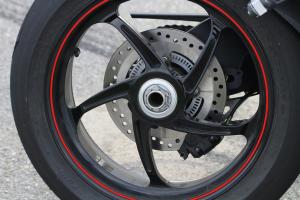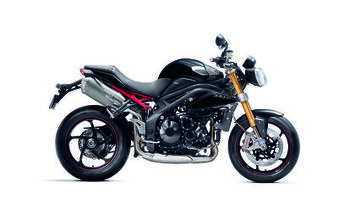2012 Triumph Speed Triple R Review - Motorcycle.com
When it comes to upping the performance of a vehicle – whether two wheels or four – simply adding the letter R to the name has seemingly become standard practice these days. It’s gotten a bit predictable, actually, and even Triumph has jumped on the bandwagon with the Street Triple and Daytona 675 both recently getting the R treatment, which includes suspension and brake upgrades and of course a few graphic touches to differentiate between the standard models.
It should come as no surprise then to see the iconic Speed Triple as the next in line to receive the R makeover. Specifically, Triumph has outfitted the new Speed Triple R with an Öhlins NIX30 43mm fork in front and a TTX36 rear shock, both tuned with higher spring rates compared to the standard model. Compression and rebound damping in the fork are separated, so each stanchion can focus on its specific task.
Braking duties are beefed up as well with Brembo monobloc calipers replacing the two-piece units on the standard model. ABS is standard on the R model, while still an option on the base version. Futzing with the gauge cluster can turn the system off, but it’s easier said than done.
The next performance modification lies in the wheels. Instead of the cast-aluminum pieces on the base model, R bikes receive forged five-spoke wheels from PVM that, combined shed 3.75 lbs of unsprung weight. Clearly, a big performance upgrade, and the first time Triumph has enlisted forged wheels to complement one of its R models.
As simple as these upgrades sound, they go a long way in transforming the character of the Speed Triple from an average, fun motorcycle, to a lean, mean, canyon carving machine. That’s saying a lot since we’ve been fans of the standard Speed Triple for a long time.
If you’ve been paying close attention, you’ll notice there’s been no mention of any engine upgrades at all. That’s because there aren’t any. The powerplant for both the standard and R version Speed Triple is the same 1050cc inline-Triple that’s become a staple for the brand. It received a slight makeover with the arrival of the revamped standard S3 introduced last year.
While it seems Triumph might have missed an opportunity to set the Speed Triple R further apart from the base model, we certainly have no qualms with the torque-monster triple. “It feels like its torque curve is a long plateau, providing effortless thrust until its top end trails off,” says boss-man Kevin Duke.
The standard Speed Triple is a sweetheart amongst the entire MO staff and puts a smile on all our faces each time we ride one. Which actually poses a challenge for the R version: Would all the new bits on the R justify its $4000 price hike over the base model?
Hooligan Reformed
First impressions can be deceiving, as is the case with the S3R. Seating position hasn’t changed on the new bike and this “combination of comfy seat and relaxed, roomy rider triangle allows a Speed Triple pilot to ride the bike for long freeway stints in relative comfort,” says Content Editor Tom Roderick.
However, Tom did notice a slight buzziness creeping through the bars at highway speeds. We think this issue could be alleviated if not for the curious lack of bar-end weights. At the very least they would help protect the controls in the event of a tip-over. “But the S3R’s vibration is more noticeable than bothersome,” Duke adds. “It’s a non-issue for me,” and I’m in agreement.
Judging from our relatively comfy freeway impressions, we could have been led to believe the S3R would be a softy in the twisty bits. Once we got to the canyons, however, the Trumpet made it clear it was a hard-edged motorcycle, blurring the line between naked streetfighter and race-ready sportbike.
“It has amazingly neutral steering that is aided by the quicker response offered by its lighter PVM forged-aluminum wheels,” says Kevin. As for the Öhlins suspension, Duke noted the suspension’s stiffer springs result in less pitching while braking and remain higher in their strokes over street bumps. “It feels planted in the corners, more so than the regular Speed Triple.”
When dealing with Brembo monobloc calipers, what is there to say that hasn’t been said already? All three testers raved about the binders, with Kevin calling them “simply excellent!” None of us noticed, let alone complained about, any ABS intervention even during our spirited riding moments. Then again, we never had much of an issue with the standard brakes either. Clutch pull could be described as slightly stiff, though old man (or should we say, drama queen?) Tom described the action as "arthritis-inducing."
R Makes All The Difference
It’s amazing the difference high-end suspension, better brakes and lighter wheels can make in transforming a motorcycle. Whereas the standard Speed Triple is more than capable to handle the rigorous testing we performed, when judged against the R it suddenly feels soft. Still, that doesn’t detract from its user-friendliness, as all three testers noted how the Speed Triple R is a familiar, comfortable and capable steed.
At $16,000, the Speed Triple R costs $4300 more than the standard model, which begs the question: Is it worth it? The easy answer is: absolutely, assuming you’ve got the money to spend. “Top-shelf Brembo monobloc brakes, Öhlins NIX30 fork and TTX36 shock live up to their reputations and help justify the $16,000 asking price,” Tom notes. Although he added, “For 16 large I’d like to see more than 122 rear-wheel ponies.”
However, for just suspension updates (albeit significant ones) and no additional power, Kevin has a harder time justifying the cost. “I could make a good case for the Triple-R to be judged as an ultimate streetbike, but I’d balk at paying $4300 more for it than a non-R version,” he says. “For my weight, I could live with the standard suspension, so the only really covetous part of the S3R to me its lightweight wheels.”
Personally, I’d agree with Tom. Try to piece together the suspension, wheels and brakes separately and you’d spend much more than four grand. You’d also have a weapon that could not only own the streets, but would also be a riot at a trackday. Which, coincidentally, is exactly where we’re taking the Speed Triple R next, along with two of its contemporaries in the naked bike category, the Aprilia Tuono V4R and MV Agusta Brutale R 1090. Stay tuned for our Euro Streetfighter Shootout to see how they all fare.
Related Reading
2012 Triumph Street Triple R Review
2012 Ducati 848 Streetfighter Review-First Ride
2011 Aprilia Tuono V4R APRC Review
2011 MV Agusta Brutale 920 Review
2011 Literbike Streetfighter Shootout
2011 Honda CB1000R Review
2011 Triumph Speed Triple 1050 Review
2010 Streetfighter Shootout: Kawasaki Z1000 vs. Triumph Speed Triple
2010 Kawasaki Z1000 Review
2009 Streetfighters Shootout: Aprilia Tuono 1000 R, Buell 1125CR, Triumph Speed Triple
More by Troy Siahaan




































Comments
Join the conversation